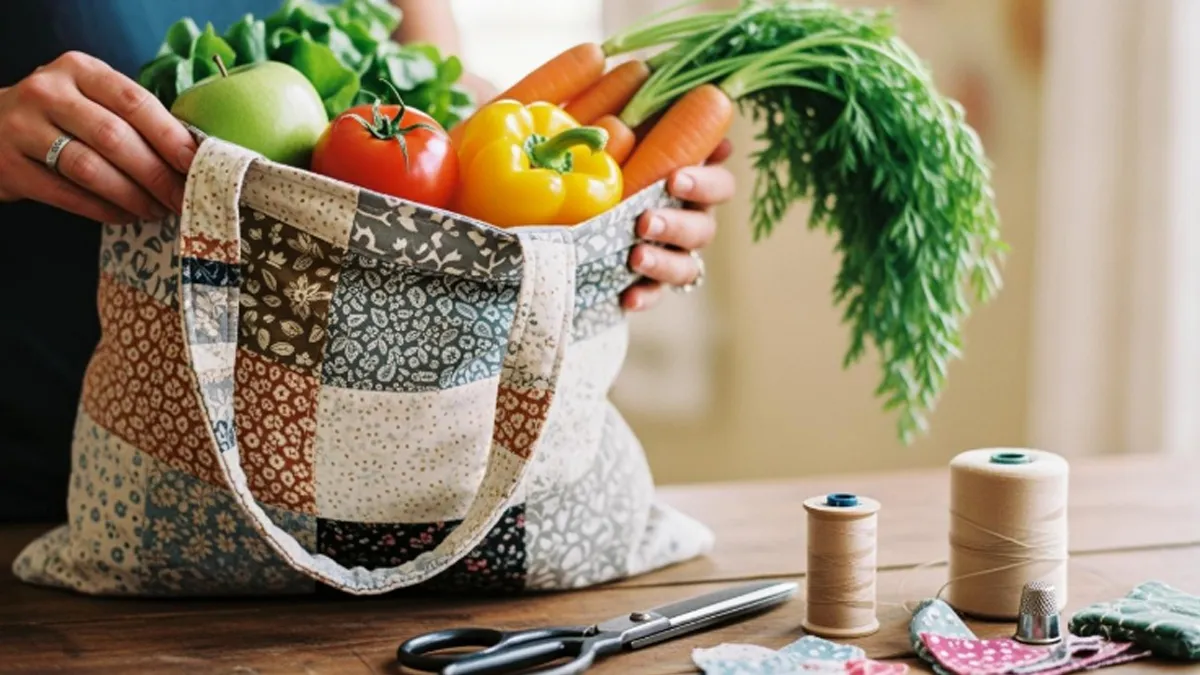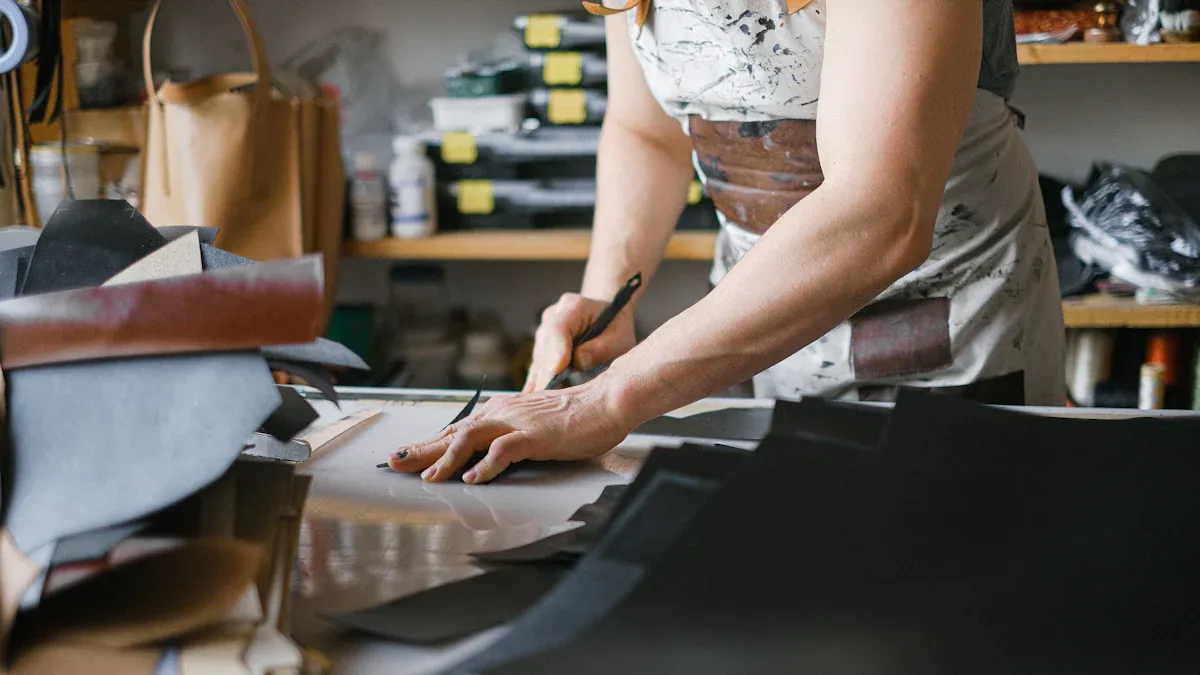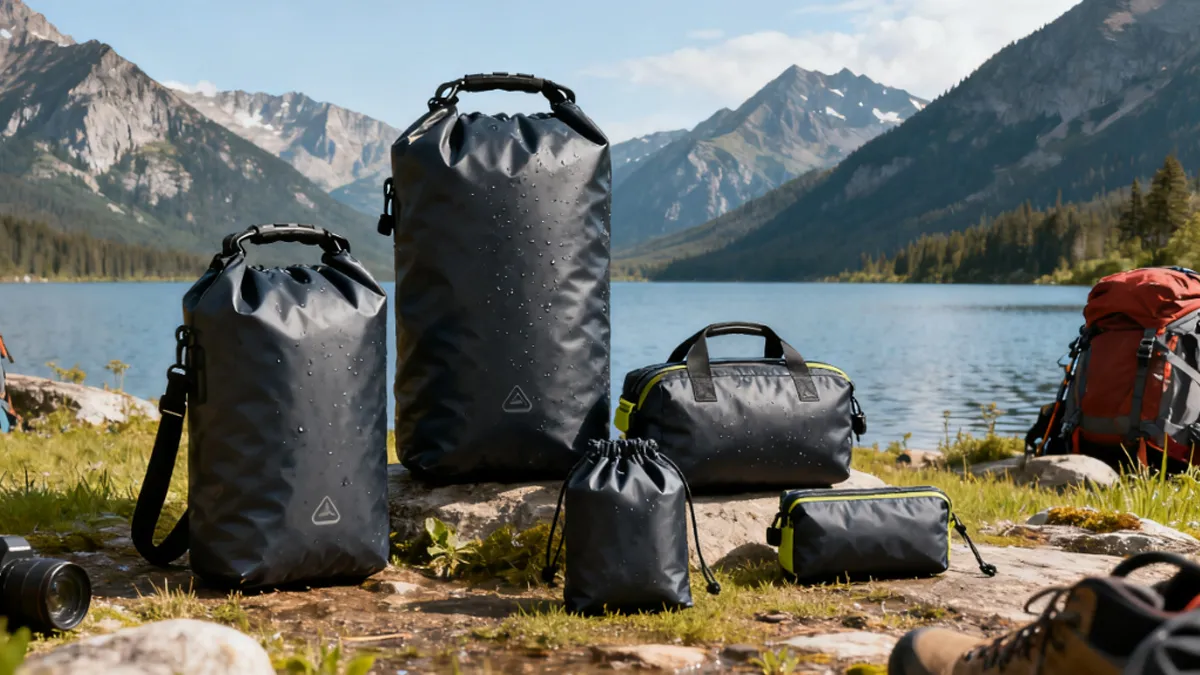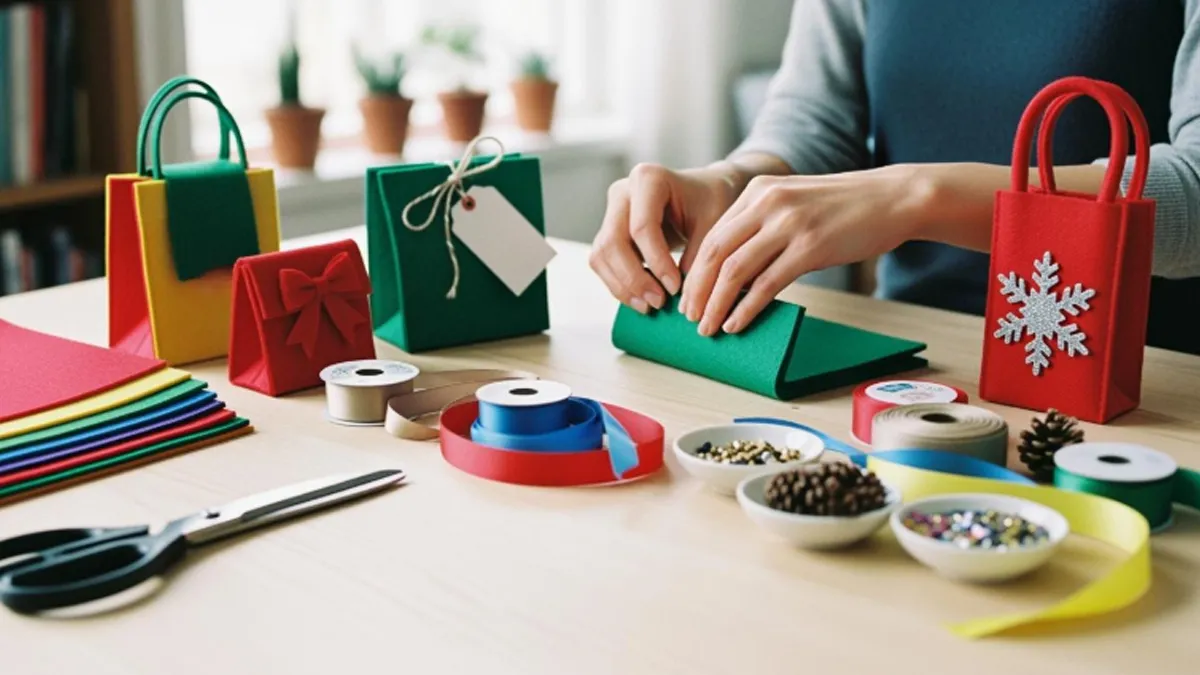You can learn how to make a grocery tote bag with reusable materials right at home. Grab some old jeans, a sturdy sheet, or any fabric you like. This project is easy to sew and perfect for beginners. You help the planet and save money at the same time. Making your own easy-sew tote bag feels rewarding. Why not give it a try? You might surprise yourself with what you can create!

Key Takeaways
- You can make a grocery tote bag from old clothes or fabric. This helps the environment because it reduces waste.
- Pick strong fabrics like cotton, canvas, or jute. These fabrics make your tote last longer.
- Gather simple sewing tools like scissors, pins, and a sewing machine or needle.
- Wash and iron your fabric before you start. This helps your bag look neat and nice.
- Sew the outside of the bag first. Then add a lining and attach strong handles. This makes your tote sturdy.
- You can add pockets, embroidery, or fabric paint to make your tote special.
- Wash your tote bag often to keep it clean and help it last longer.
- Making your own tote saves money. It also lets you be creative and helps the planet.
Materials and Tools
Before you start making your lined fabric tote bag, you need to gather the right materials needed for the project. Picking the best supplies makes your sewing experience smoother and your bag stronger.
Reusable Fabric Choices
You can turn many old items into a new tote. Choosing the right fabric helps your lined fabric tote bag last longer and look great.
Old Clothes and Linens
Look around your home for fabric you can reuse. Old jeans, shirts, or bed sheets work well. These items often have strong fabric that holds up to heavy groceries. You also help the planet by keeping textiles out of landfills. Did you know that in 2018, fabric and textile waste in the U.S. made up 7.7% of all landfill materials? That’s over 11 million tons! By upcycling, you cut down on waste and make something useful.
Durable Options
Some fabrics stand out for tote bags. Here are some popular choices:
- Cotton fabric: You can find it in traditional, organic, or recycled forms. It’s soft, easy to sew, and eco-friendly.
- Canvas fabric: This is a heavier cotton. It’s tough and perfect for a lined fabric tote bag.
- Jute fabric: Made from plant fibers, jute is strong and has a natural look.
- Hemp fabric: This fabric is sustainable, needs less water, and breaks down naturally.
| Evidence Type | Description |
|---|---|
| Emissions from Textile Production | 1.2 billion tonnes of greenhouse gas emissions produced annually, more than all international flights and maritime shipping combined. |
| Contribution to Landfill | In 2018, fabric and textile waste in the U.S. accounted for 7.7% of all materials sent to landfill, weighing 11.3 million tons. |
| Industry Emissions Rank | The fashion and textile industry is the 3rd largest contributor of emissions globally, accounting for 5% of all emissions. |
Essential Sewing Tools
You don’t need fancy equipment to make a tote. Here’s what you should have ready:
Scissors, Tape, Pins
- Scissors: For cutting fabric.
- Thread clippers: For trimming threads.
- Sewing clips or pins: To hold pieces together.
- Ruler: To measure straight lines.
- Iron or heat press: To smooth out fabric and seams.
Tip: Keep your tools close by so you don’t lose track while sewing!
Sewing Machine or Hand Sewing
A sewing machine makes the job faster, but you can sew by hand if you don’t have one. Both methods work for a lined fabric tote bag. Just make sure your stitches are tight and even.
Optional Add-ons
Want to make your tote even better? Try these ideas:
- Add pockets for keys or your phone.
- Make your bag reversible with two fabrics.
- Personalize with embroidery or applique.
- Use buttons, snaps, or zippers for closures.
These extras help your tote stand out and fit your needs. Have fun and get creative!
Prepare the Fabric
Getting your fabric ready is a big step in making a grocery tote bag. Clean, smooth fabric makes sewing easier and helps your bag look neat. Let’s walk through how you can prep your materials for the best results.
Wash and Iron
You want your tote bag to last, so start by washing and ironing your fabric. This step removes dirt, softens the fibers, and prevents shrinking later. Here’s a simple way to get your upcycled fabric ready:
- Sort your fabric by color. This keeps colors from bleeding onto each other.
- Prep your washing machine. Choose a gentle, cool water cycle. This helps avoid shrinking and color bleeding.
- Load your fabric into the washing machine. Don’t overcrowd it. Give the fabric space so it doesn’t twist or warp.
- Dry your fabric. Use a low heat setting in the dryer or hang it up to dry. This keeps the fabric from getting brittle.
- Iron your fabric. Use the right heat setting for your material. Ironing removes wrinkles and makes it easier to measure and cut the fabrics.
Tip: Always check the care label if you’re using old clothes or linens. Some fabrics need special care.
Measure and Cut
Now that your fabric is clean and smooth, you can measure and cut the fabrics for your tote bag. This step sets the shape and size of your finished bag.
Standard Tote Size
Most grocery tote bags follow a few common sizes. You can pick one that fits your needs. Here’s a quick guide to help you choose:
| Size | Dimensions (W x H x D) | Use Cases |
|---|---|---|
| Large | 22″W x 15″H x 8″D | Beach, pool, overnight bags |
| Medium | 16″W x 15″H x 5″D | Everyday, giveaway, school, coffee bags |
| Small | 12″W x 13″H x 4″D | Book, wedding, gift, school bags |
If you want a classic grocery tote, go with the medium size. It’s roomy enough for groceries but not too bulky.
Custom Sizing
You might want a bag that’s just right for you. Maybe you need a smaller tote for books or a bigger one for the beach. Grab a ruler or measuring tape and decide how big you want your bag. Mark your measurements on the fabric with chalk or a washable marker. Then, cut the fabrics along your lines. Take your time and keep your lines straight for a neat finish.
Remember: Always double-check your measurements before you cut the fabrics. It’s easier to fix a mark than a cut!
How to Make a Grocery Tote Bag

Ready to dive in? Here’s your step-by-step guide for how to make a grocery tote bag using reusable materials. You’ll learn how to sew each part, from the outer bag to the handles. Let’s get started!
Sew the Outer Bag
You’ve already measured and cut your fabric. Now, you’ll sew the main part of your tote. Follow these steps for a sturdy, neat finish:
- Lay out your outer fabric pieces with the right sides facing each other.
- Pin the edges together. This keeps everything lined up while you sew.
- Sew along the sides and bottom using a 3/8″ seam allowance. Backstitch at the beginning and end for extra strength.
- Press the seams open with an iron. This helps your bag look crisp and professional.
- To give your tote a flat bottom, pinch each corner so the side and bottom seams meet. Pin and sew across the corners. Backstitch here for durability.
- Finish the raw edges with a zig-zag stitch or serger. This prevents fraying and keeps your bag looking good after many washes.
Tip: Use strong thread and keep your stitches even. This makes your tote last longer and hold heavier groceries.
You just finished the outer part of your bag! You’re learning how to sew like a pro.
Add the Lining
A lining makes your tote bag stronger and gives it a polished look. You can use cotton, organic cotton, or recycled cotton for the lining. These fabrics are soft, durable, and easy to wash.
- Cut your lining fabric to match the size of your outer bag.
- Pin the lining pieces together with right sides facing.
- Sew the sides and bottom, just like you did for the outer bag.
- Press the seams open for a neat finish.
If you want to add pockets, now’s the time. Sew them onto the lining before you assemble the bag.
Note: Organic cotton and recycled cotton are great choices if you want an eco-friendly tote. They help reduce landfill waste and feel nice to the touch.
Make and Attach Handles
Handles are the finishing touch for your grocery tote. You want them strong and comfortable. Here’s how to sew and attach them:
Cut and Sew Strips
- Cut two strips of fabric for the handles. Standard handles are about 22 inches long and 2 inches wide.
- Fold each strip in half lengthwise, right sides together.
- Sew along the long edge. Turn the strip right side out.
- Press the handle flat with an iron.
Tip: For extra strength, use double layers or add interfacing inside the handles.
Attach to Bag
- Pin the handles to the top edge of your outer bag. Space them evenly from each side.
- Sew the handles in place using a box stitch or an ‘X’ stitch. This makes them super strong.
- You can also use rivets or grommets for a modern look and extra durability. Riveted handles support heavy loads and look stylish.
- Reinforce the attachment points with extra stitching or interfacing. This prevents tearing, even when you carry heavy groceries.
Some people like to use clips or rings for removable handles. This adds flexibility if you want to swap out the straps.
Tip: Always double-check the placement before you sew. Make sure the handles aren’t twisted and are spaced evenly.
Now you know how to sew sturdy handles that will last. Your grocery tote bag is almost ready!
Join Lining and Outer Bag
You’re almost done with your tote! Now it’s time to join the lining and the outer bag. This step gives your project a clean, professional look. You have a couple of easy ways to do this, and both work well for beginners learning how to make a grocery tote bag.
- Method without Binding
This is the most popular way for beginners. Start by turning your outer bag right side out. Keep your lining inside out. Slip the outer bag into the lining so the right sides face each other. Line up the side seams and pin around the top edge. Sew all the way around the top, but leave a small opening (about 3 inches) so you can turn the bag right side out.
Once you finish sewing, gently pull the bag through the opening. Push the lining down into the bag. Use your fingers to smooth out the corners and seams. Fold in the raw edges at the opening and pin them together. Topstitch around the entire top edge. This closes the opening and gives your tote a crisp finish. - Method with Binding
If you want a little extra detail, try this method. Place the lining inside the outer bag with the wrong sides facing each other. Tuck in the raw edges at the top. Use a strip of binding to cover the raw edges. You can use double-sided fusible tape to help hold the binding in place before you sew. Stitch all the way around the top edge to secure the binding. This adds a nice accent and keeps everything tidy.
Tip: Take your time lining up the seams and corners. A little patience here makes your tote look store-bought!
No matter which method you choose, you’ll end up with a sturdy, neat bag. If you’re following these steps for how to make a grocery tote bag, you’ll see how easy it is to get a polished result. Give your bag a final press with the iron, and you’re ready to fill it with groceries or anything else you need to carry!
Finish the Easy-Sew Tote Bag
Hem the Top Edge
You want your tote bag to look neat and last a long time. Hemming the top edge is a simple step that makes a big difference. You have a few easy options to keep the fabric from fraying and give your bag a clean finish:
- Fold the raw edge over twice, press it flat, and sew it down. This double-fold hem hides the raw edge and looks tidy.
- Use zigzag stitching along the edge. This helps stop the fabric from fraying, especially if you don’t have a serger.
- Try hem tape if you want a no-sew option. Just press it on with an iron for a quick finish.
- Cut the edge with pinking shears. The zigzag pattern helps reduce fraying and adds a fun touch.
- Add zigzag stitching to the seam allowances for extra security.
Tip: Take your time when you hem. A straight, even hem makes your tote look professional and helps it last longer.
Add Pockets or Lining (Optional)
You can make your tote bag even more useful by adding pockets or a lining. Pockets give you a spot for your phone, keys, or shopping list. You can sew a simple square pocket onto the lining or the outside of your bag. Just cut a piece of fabric, fold the edges under, and sew it in place.
A lining gives your bag extra strength and a smooth inside. If you want to add a lining, cut fabric the same size as your outer bag. Sew the lining together, then tuck it inside your tote before you hem the top edge. You can also add small pockets to the lining for extra storage.
Note: You can skip these steps if you want a quick project. Your tote will still work great!
Personalize Your Bag
Now comes the fun part! You can turn your tote into something special with a few creative touches. Here are some ideas to inspire you:
- Paint flowers in bright colors for a cheerful look.
- Try an ombre effect with watercolors.
- Pour paint for a cool, abstract design.
- Add a funny meme for a playful vibe.
- Write your favorite quote on the bag.
- Use food themes, like fruits or veggies.
- Draw something from your favorite book or character.
- Add your name or monogram.
- Create a simple repeating pattern.
- Decorate with coffee-themed images.
- Paint your pet for a personal touch.
- Make a tie-dye effect with acrylic paints.
- Use lyrics or music notes for a musical theme.
- Host a painting party with friends and decorate together.
- Splash paint for a wild, fun design.
You can sew on patches, buttons, or even fabric shapes. Try embroidery if you want to add texture. Your tote bag can show off your style and make you smile every time you use it.
Remember: There’s no right or wrong way to decorate your tote. Let your creativity shine!
Tips for How to Sew with Reusable Materials
Best Upcycled Fabrics
You want your tote bag to last and look good. Picking the right upcycled fabric makes a big difference. Old jeans, sturdy shirts, and cotton sheets work well. These fabrics hold up to heavy groceries and daily use. Cotton canvas and linen are also great choices. They are easy to sew and keep their shape. If you find hemp or jute fabric, you can use those for a natural look.
| Fabric Type | Why It Works Well | Best Use |
|---|---|---|
| Denim | Strong, durable | Outer bag, handles |
| Cotton Sheet | Soft, easy to sew | Lining, pockets |
| Canvas | Tough, holds shape | Outer bag |
| Linen | Stable, simple to cut | Lining, outer bag |
| Jute/Hemp | Eco-friendly, sturdy | Outer bag, accents |
Tip: Stick with stable fabrics like cotton or linen if you are new to sewing. These fabrics do not slip or stretch much, so you get a neat finish.
Troubleshooting
Sewing with upcycled materials can be fun, but you might run into a few problems. Here are some common mistakes beginners make and how you can avoid them:
- Using the Wrong Needle for Your Fabric
Match your needle to your fabric. Thick denim needs a heavy-duty needle. Thin cotton works best with a smaller needle. This helps you avoid bunching or breaking thread. - Not Pressing as You Sew
Press your seams with an iron after each step. This keeps your bag flat and smooth. You get a professional look and avoid puckering. - Ignoring the Grainline When Cutting
Always check the grainline before you cut. Measure from the grainline arrow to the edge of the fabric. This keeps your bag from twisting or losing its shape. - Choosing the Wrong Fabric for Your Project
Pick stable fabrics like cotton lawn or linen. These are easier to handle and sew. Avoid slippery or stretchy materials until you feel more confident.
If you make a mistake, do not worry. You can always rip out stitches and try again. Practice makes perfect!
Care Instructions
You want your tote bag to stay clean and last a long time. Here are some easy ways to care for your bag:
- Wash cloth bags in the washing machine with hot water and detergent.
- Always air-dry your bag completely before you use it again.
- For spot cleaning, use mild laundry detergent and lukewarm water.
- Gently scrub with a clean towel or soft brush. Do not scrub too hard, or you might damage the fabric.
- Rinse well in cool water to remove all detergent.
- Wash your tote bag after each shopping trip to stop bacteria from growing.
- If you use your bag every day, wash it every few weeks.
Note: Clean bags last longer and keep your groceries safe. Regular washing helps your tote stay fresh and strong.
Now you know how to pick the best fabrics, avoid common mistakes, and keep your tote bag clean. Sewing with reusable materials is easy when you follow these tips!
Why Make Your Own Tote Bag?
Eco-Friendly Benefits
When you make your own tote bag, you help the planet in a big way. You cut down on plastic waste every time you use your bag instead of a single-use plastic one. Plastic bags often end up in landfills or oceans, where they can take hundreds of years to break down. Your homemade tote, especially if made from canvas or cotton, can last for years and decompose much faster than plastic.
- Canvas tote bags are strong and can be reused many times, so you need fewer plastic bags.
- Using reusable totes helps lower plastic waste, which is a big problem for pollution and landfills.
- Canvas bags break down faster than plastic, which sticks around for centuries.
- Studies show that you need to reuse a canvas bag thousands of times to make it more eco-friendly than a plastic bag. So, the more you use your tote, the better it is for the environment.
Reusable bags come in different materials, like cotton and non-woven polypropylene. Cotton bags take more resources to make, but they become a smart choice when you use them often. Non-woven polypropylene bags need even fewer uses to balance out their impact. Here’s a quick look at how reusable bags compare to disposable ones:
| Aspect | Reusable Bags | Disposable Bags |
|---|---|---|
| Environmental Awareness | Supports eco-conscious consumers | Often linked to environmental harm |
| Material Usage | Made from sustainable materials | Made from non-renewable resources |
| Reuse Requirement | Must be reused many times for benefits | Single-use, adds to waste |
Tip: A cotton bag needs to be reused about 131 times to make up for its production, while a non-woven polypropylene bag only needs 11 uses to break even with plastic.
Save Money
You save money every time you bring your own tote to the store. Many stores now charge for plastic bags, so using your own bag means you skip those extra fees. You also spend less because you reuse materials you already have at home, like old jeans or sheets. You don’t need to buy new fabric or fancy supplies. Your homemade tote can last for years, so you avoid buying new bags over and over.
- No more paying for single-use bags at checkout.
- Use what you already have, so you don’t need to buy new materials.
- A sturdy tote lasts longer than most store-bought bags.
Note: Making your own bag is a one-time project that keeps saving you money every time you shop.
Customization and Gifting
You get to show off your style when you make your own tote bag. You can pick your favorite colors, add fun designs, or even put your name on it. Homemade totes also make great gifts for friends and family. You can create a bag that matches someone’s hobbies or favorite colors.
Here are some ways you can customize your tote:
- Fabric Painting: Paint your own designs with fabric paints and brushes.
- Iron-on Transfers: Print a design and use an iron to put it on your bag.
- Embroidery: Stitch patterns or words with embroidery floss.
- Tie-Dye: Twist and dye your bag for a colorful look.
You can make each bag unique. Add pockets, patches, or even a special message. Your homemade tote can become a one-of-a-kind gift that shows you care.
A personalized tote bag is useful, thoughtful, and always in style!
Conclusion
You just learned how to make your own grocery tote bag with reusable materials. This project is simple, fun, and helps the planet. Here are some big benefits you get:
- Jute and cotton bags break down fast and last a long time.
- Tote bags save money and cut down on plastic waste.
- You can use them for shopping, books, or sports.
Looking for custom or wholesale tote bags? Check out what most people ask for:
| Request Type | What Customers Want |
|---|---|
| Custom Logo | Bags for promotions |
| Eco-Friendly | Reusable, recyclable materials |
| Fast Fulfillment | Quick, large order delivery |
| Unique Designs | Special materials and styles |
Try making your own or reach out for a personalized tote bag solution!
FAQ
How do I choose the best fabric for my tote bag?
Pick sturdy fabrics like denim, canvas, or old cotton sheets. These hold up well and are easy to sew. If you want a softer look, try linen or recycled cotton.
Can I make a tote bag without a sewing machine?
Yes! You can sew your tote bag by hand using a needle and strong thread. It takes more time, but you still get a durable bag. Use small, tight stitches for strength.
What size should my grocery tote bag be?
Most people like a medium size: about 16 inches wide, 15 inches tall, and 5 inches deep. This fits groceries and books. You can adjust the size to fit your needs.
How do I clean my reusable tote bag?
Wash your bag in the washing machine with hot water and detergent. Air-dry it completely before using again. For quick cleaning, spot wash with mild soap and a soft brush.
Can I add pockets or decorations to my tote bag?
Absolutely! Sew on pockets for keys or phones. Decorate with fabric paint, patches, or embroidery. Personal touches make your tote unique and fun to use.
What if my fabric frays while sewing?
Use zigzag stitching or pinking shears on the edges. This helps stop fraying and keeps your bag looking neat after many washes.




